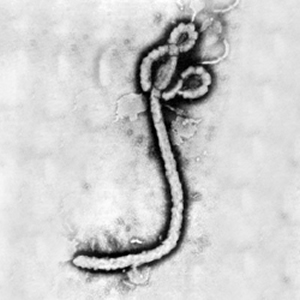Tuberculosis and HIV: Difference between revisions
Itounkel8328 (talk | contribs) No edit summary |
Itounkel8328 (talk | contribs) No edit summary |
||
| Line 5: | Line 5: | ||
Human Immunodeficiency Virus is the biggest predisposing factor for tuberculosis, with 10 percent of HIV positive individuals infected. HIV significantly increases the risk of latent tuberculosis developing into disease. | Human Immunodeficiency Virus is the biggest predisposing factor for tuberculosis, with 10 percent of HIV positive individuals infected. HIV significantly increases the risk of latent tuberculosis developing into disease. | ||
== | ==Tuberculosis== | ||
[[Image:Ebola virus 1.jpeg|thumb|300px|right|Electron micrograph of the Ebola Zaire virus. This was the first photo ever taken of the virus, on 10/13/1976. By Dr. F.A. Murphy, now at U.C. Davis, then at the CDC.]] | [[Image:Ebola virus 1.jpeg|thumb|300px|right|Electron micrograph of the Ebola Zaire virus. This was the first photo ever taken of the virus, on 10/13/1976. By Dr. F.A. Murphy, now at U.C. Davis, then at the CDC.]] | ||
| Line 28: | Line 28: | ||
<br> <br> | <br> <br> | ||
== | ==HIV== | ||
<br>Include some current research in each topic, with at least one figure showing data.<br> | <br>Include some current research in each topic, with at least one figure showing data.<br> | ||
== | ==Studies on the Relationship Between Mycobacterium tuberculosis and HIV== | ||
<br>Include some current research in each topic, with at least one figure showing data.<br> | <br>Include some current research in each topic, with at least one figure showing data.<br> | ||
==Effects on Antibiotic Resistance== | |||
==Concluding Remarks== | |||
==Further Reading== | ==Further Reading== | ||
Revision as of 19:06, 20 March 2014
Mycobacterium tuberculosis and Human Immunodeficiency Virus are both diseases that plague many developing countries. Currently there is an extensive discourse on the relationship between the two diseases, and whether or not there is a correlation between their effects and multi-drug resistant tuberculosis.
Tuberculosis is caused by the bacteria called
Mycobacterium tuberculosis. This bacterium is nonmotile and rod-shaped, 2-4 micrometers in length and 0.2-0.5 um in width. Because this bacterium is classified as an obligate aerobe, it is commonly found in the lungs, however, complicaions in the kidneys, spine, and brain arise (CDC) Additionally,
Mycobacterium tuberculosis has a generation time of 15-20 hours, and is an acid-fast bacteria due to its unique cell walls, which contain mycolic acids and a high concentration of lipids. This high concentration of lipids in the cell wall allows the bacterium to be impermeable to many stains and resistant to antibiotics, acidic and alkaline compounds, osmotic lysis, and lethal oxidations.
Tuberculosis is highly contagious and spreads through the airborne transfer of
Mycobacterium tuberculosis from an infected individual to others (i.e. through coughing and sneezing). There are two distinctions, latent infection and disease, that are ascribed to tuberculosis. Latent infection means that an individual has been exposed to the bacterium, but the immune system is able to control the bacterial growth, and consequently the disease from developing. These individuals are not contagious and do not experience any tuberculosis related symptoms. Tuberculosis disease occurs when the bacterium continues to multiply beyond the control of the immune system. Individuals with the disease experience coughing up blood and sputum, coughing, weight loss, fatigue, fever, pain in the chest, and loss of appetite. Left untreated, tuberculosis can be fatal.
Human Immunodeficiency Virus is the biggest predisposing factor for tuberculosis, with 10 percent of HIV positive individuals infected. HIV significantly increases the risk of latent tuberculosis developing into disease.
Tuberculosis
At right is a sample image insertion. It works for any image uploaded anywhere to MicrobeWiki. The insertion code consists of:
Double brackets: [[
Filename: Ebola virus 1.jpeg
Thumbnail status: |thumb|
Pixel size: |300px|
Placement on page: |right|
Legend/credit: Electron micrograph of the Ebola Zaire virus. This was the first photo ever taken of the virus, on 10/13/1976. By Dr. F.A. Murphy, now at U.C. Davis, then at the CDC.
Closed double brackets: ]]
Other examples:
Bold
Italic
Subscript: H2O
Superscript: Fe3+
Overall paper length should be 3,000 words, with at least 3 figures with data.
HIV
Include some current research in each topic, with at least one figure showing data.
Studies on the Relationship Between Mycobacterium tuberculosis and HIV
Include some current research in each topic, with at least one figure showing data.
Effects on Antibiotic Resistance
Concluding Remarks
Further Reading
[Sample link] Ebola Hemorrhagic Fever—Centers for Disease Control and Prevention, Special Pathogens Branch
References
Edited by (your name here), a student of Nora Sullivan in BIOL168L (Microbiology) in The Keck Science Department of the Claremont Colleges Spring 2014.

